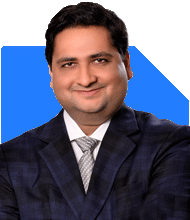22-Year-Old Investor Seeks Advice on Mutual Fund Allocation
Ramalingam Kalirajan |10872 Answers |Ask -Follow
Mutual Funds, Financial Planning Expert - Answered on Dec 16, 2024
He has an MBA in finance from the University of Madras and is a certified financial planner.
He is the director and chief financial planner at Holistic Investment, a Chennai-based firm that offers financial planning and wealth management advice.... more

My age is 22,Its my first time in mutual funds Total amount:25,000 Allocation:20%,30%,30%,20% This are my mutual funds 1. HDFC nifty 50 index fund (5000rs) 2.Motilal oswal midcup fund(7500rs) 3.Quant small Cap fund (7500rs) 4.Parag Parikh Flexi Cup fund(5000rs technical large cup) Is this the right allocation and right mutual fund i will do my research properly if there is anything wrong with it I am thinking about not investing in hdfc nifty because ppfc is technically a large cup what are your opinions?
Asset Allocation Review
Your allocation of 20%, 30%, 30%, and 20% is balanced across large-cap, mid-cap, small-cap, and flexi-cap categories.
This diversification reduces risks and allows participation in different market segments.
Your focus on mid-cap and small-cap funds (60%) indicates a higher risk tolerance. This is suitable for your age but requires periodic review.
Insights on Individual Categories
1. Large-Cap Fund
You are considering replacing your large-cap fund because the flexi-cap fund overlaps with this category.
Flexi-cap funds allocate dynamically across large, mid, and small caps. This makes your large-cap fund somewhat redundant.
However, large-cap funds offer stability, especially during market downturns. Evaluate if removing this fund aligns with your risk profile.
2. Mid-Cap and Small-Cap Funds
Allocating 30% each to mid-cap and small-cap funds demonstrates a growth-oriented approach.
These funds have higher potential for long-term returns but also come with higher volatility.
You should remain invested for at least 7-10 years to maximise benefits.
3. Flexi-Cap Fund
Flexi-cap funds provide flexibility to invest across market caps.
This fund complements your portfolio well as it adapts to changing market conditions.
Retain this fund as it balances risk and reward effectively.
Observations on Portfolio Design
Overlaps in Fund Categories:
Your flexi-cap fund may already invest in large-cap stocks. This makes your standalone large-cap fund less critical.
Weightage Adjustment:
Consider reducing exposure to small-cap funds slightly (from 30% to 20%) if you want to lower risk.
Simplicity Matters:
Avoid adding too many funds in the future. A cluttered portfolio complicates tracking and performance evaluation.
Disadvantages of Index Funds
Index funds lack the flexibility to adjust to market conditions. They mirror the index and cannot outperform it.
Actively managed funds have experienced managers who can select outperforming stocks.
Active funds provide better returns in emerging markets like India due to market inefficiencies.
Avoiding Direct Mutual Funds
Direct funds save on commissions but require hands-on management and regular reviews.
Investing through a Certified Financial Planner (CFP) ensures expert guidance, periodic rebalancing, and stress-free investing.
A CFP helps you select funds that align with your financial goals.
Tax Implications
Gains from equity funds held for over one year are classified as long-term capital gains (LTCG).
Gains up to Rs. 1.25 lakh per year are tax-free. Beyond this, LTCG is taxed at 12.5%.
Short-term capital gains (STCG) on equity funds are taxed at 20%.
Understand the tax impact of redeeming funds before selling.
Long-Term Wealth Building
Your young age gives you an edge. Compounding works best over the long term.
Aim to increase investments periodically as your income grows.
Set specific financial goals (e.g., buying a house, retirement) and align your investments with them.
Steps to Strengthen Your Investment Strategy
Reevaluate Risk Appetite:
While mid-cap and small-cap funds promise high returns, ensure you can tolerate market fluctuations.
Reassess Large-Cap Fund:
If you prefer stability, keep the large-cap fund. If not, redistribute this amount into other funds.
Regular Monitoring:
Review your portfolio annually and rebalance if needed.
Stay Disciplined:
Market corrections are normal. Avoid frequent changes based on short-term performance.
Emergency Fund:
Ensure you maintain a separate emergency fund. This prevents premature withdrawals from your mutual funds.
Final Insights
Your portfolio is well-designed for a first-time investor. With small tweaks, it can achieve even better balance.
Avoid focusing only on returns. Consider risks, goals, and your investment horizon.
Invest consistently, and let compounding work its magic.
Best Regards,
K. Ramalingam, MBA, CFP,
Chief Financial Planner,
www.holisticinvestment.in
https://www.youtube.com/@HolisticInvestment
You may like to see similar questions and answers below
Hardik Parikh | Answer |Ask -Follow
Tax, Mutual Fund Expert - Answered on May 03, 2023
Ramalingam Kalirajan |10872 Answers |Ask -Follow
Mutual Funds, Financial Planning Expert - Answered on Apr 15, 2024
Ramalingam Kalirajan |10872 Answers |Ask -Follow
Mutual Funds, Financial Planning Expert - Answered on May 15, 2024
Ramalingam Kalirajan |10872 Answers |Ask -Follow
Mutual Funds, Financial Planning Expert - Answered on Jan 30, 2025
Radheshyam Zanwar |6735 Answers |Ask -Follow
MHT-CET, IIT-JEE, NEET-UG Expert - Answered on Dec 06, 2025
Dr Nagarajan J S K |2576 Answers |Ask -Follow
NEET, Medical, Pharmacy Careers - Answered on Dec 06, 2025
Mihir Tanna |1090 Answers |Ask -Follow
Tax Expert - Answered on Dec 06, 2025
Ramalingam Kalirajan |10872 Answers |Ask -Follow
Mutual Funds, Financial Planning Expert - Answered on Dec 06, 2025
Radheshyam Zanwar |6735 Answers |Ask -Follow
MHT-CET, IIT-JEE, NEET-UG Expert - Answered on Dec 06, 2025
Radheshyam Zanwar |6735 Answers |Ask -Follow
MHT-CET, IIT-JEE, NEET-UG Expert - Answered on Dec 06, 2025
Radheshyam Zanwar |6735 Answers |Ask -Follow
MHT-CET, IIT-JEE, NEET-UG Expert - Answered on Dec 06, 2025
Dr Dipankar Dutta |1837 Answers |Ask -Follow
Tech Careers and Skill Development Expert - Answered on Dec 05, 2025
Dr Shyam Jamalabad |108 Answers |Ask -Follow
Dentist - Answered on Dec 05, 2025
Dr Shyam Jamalabad |108 Answers |Ask -Follow
Dentist - Answered on Dec 05, 2025

























